
Cloudeight InfoAve Weekly
Issue #1137
Volume 22, Number 40
July 25, 2025
Dear Friends,
Welcome to Cloudeight InfoAve Weekly Issue #1137. Thank you for subscribing and for being a part of our Cloudeight family. We appreciate your friendship and support very much! Please share our newsletters and our website with your friends and family.
If you're not getting our InfoAve Daily newsletter, you're missing out on a lot of good stuff!
It's free and it only takes a few seconds to sign up. We'd love to have you with us. Visit this page to sign up for our Cloudeight InfoAve Daily Newsletter.
![]()
We gladly help everyone who writes every day by answering their questions and helping to solve their computer problems. Please help us continue to do that!
Make a small donation and help us help you!
If you don't need any of our products or services right now, please help us with a donation. Even the smallest gift is appreciated. Every donation helps us to provide useful information that helps you with your computer, as well as helps us to keep you safe on the Internet. We offer free help to thousands of people every year... and we offer an honest and inexpensive computer repair service too. We do everything we can to help you with your computer and keep you safe, too.So if you don't need any of our products or services right now, please help us by making a donation.
Interested in making a monthly gift? Visit this page. Help us keep helping you!
Thank you so much for your support!
![]()

We are both entering our tenth decade and are moving into a Senior living facility. Internet is provided, but the description says "shared internet". Would you think that means reduced privacy? I'd think so. Is a VPN the answer or is there some other way to ensure some degree of privacy for such things as banking? Also, we now have Chromebooks and love them so far. I'm not sure if you have written about them, but we'd love to hear your thoughts about them. Many thanks for all the help you have given to us and others--We go way back to Zappit.
Hi Everett. Thanks for your kind words and long-time support.
We don't generally recommend VPNs for home use, however. in your case, a VPN would be a good idea. A VPN would provide you with privacy in a public (open) Wi-Fi environment. Right now, NordVPN is probably the easiest to use, but it's not free.
We have used Chromebooks and they work well. But, if you're interested in privacy they're not the best solution since everything is stored on Google servers and not on your device.
![]()
Ron is confusing
corrupted files with
infected files - we try
to clean things up
I have some
problems that I have not
been able to solve, and
I need help and I do not
know who to turn to.
I have Windows 11 with Office 10 (which is now 4 years out of date and not supported.
I received emails from Cloudeight who recommended that we use Emsisoft which I have been using for some time and have not had any problems with viruses or Malware...
My problem is that on four occasions, I have opened a file to find that it is corrupted. When I open it is all code and unreadable. I could have many more files that I have not opened and discovered.
The last file that it happened to I had saved an email that contained details for a Square Dance convention to be held next weekend into a folder and when I opened it was corrupt and unreadable. One of the previous files was a Word file where I added records, dates and details of every medical visit I made. It happened to the medical file and I lost a file that dated back many years and I am lucky I had a backup of this file.,
Our answer
Hi Ron. I think you're
confusing corrupted files
with files infected with
malware. While it's
conceivable that file
corruption can be caused by
malware it's not very
likely. There are many more
likely reasons for files
becoming corrupted, mainly
due to storage device
problems and transfer
problems.
Bad sectors: These are areas on the hard drive that are physically damaged and can no longer store data reliably.
Hard drive failure: As hard drives age, they become more prone to failure, leading to data loss and corruption.
![]()
I’m having 2 issues with Outlook Mail that are driving me nuts. I also use Yahoo Mail and Gmail without these issues, but I like Outlook best. These issues are on both the online and stand-alone versions of Outlook. I use a laptop with a touchscreen. When at my desk I use a mouse. When using the mouse there are no issues. The touchpad is useless. When using the touchscreen when I open an email to read it, it opens in a new small window instead of a new tab. Then, if I click on a link within the email nothing happens. So, if I want to look at the link information, I have to do it at my desk. Not ideal. I’ve searched the settings without finding the issues.
I’m a long-time reader... You do great work. Richard.
Our answer
Hi Richard. Thanks for your long-time support.
![]()
Does Emsisoft anti-malware work in Australia? Is it easy to install? I have Norton which doesn’t seem to have a good reputation. Would I have to uninstall Norton before I install Emsisoft? Thank you in advance, June.
Our answer
Hi June. Emsisoft works worldwide. Emsisoft's headquarters are in Nelson, NZ, and it maintains a worldwide workforce. Emsisoft is a breeze to install. When you purchase Emsisoft from us, we'll send you a link from which you can download Emsisoft that includes your license and configures Emsisoft automatically when you install it. Learn more about and get Emsisoft here.
![]()
We can fix your Windows computer... check out our low prices here!
![]()
JP wants to know what to do if his computer crashes
This is a question that we old-timers might ask. I had a bad dream the other night that my computer crashed, and I was lost in what to do next since I wouldn't be able to get in touch for help. It is my only connection to the internet in my apartment. My mind goes blank. Could you suggest what steps I could take to restore my computer? Do I bring it to the repair shop in the hope they can fix the problem, or do I trash it and get another computer? Thanks.\
Our answer
Hi JP. We've written a complete guide of what you can do if your computer crashes - you have several options and they are all included in our guide which you can read and print by visiting this page.
![]()
Barb's getting a new computer and wants help setting it up
I am getting a new computer soon. I would like you to log in and take everything off of the computer that I don't need, install what I do need, and optimize it so it's as fast as it can be. I would like you to install Emsisoft on my new computer for me. Thanks again to you both for all you do and all the help you give us.
Our answer
Hi Barb. Thanks for your nice comments. We can optimize and set up your new computer for the best performance and appearance. We can help you transfer files from an external drive to your new computer. All you need is a Cloudeight Direct Computer Care Key available from this page.
If there is time left on your Emsisoft license, we'll get that installed for you as well, and whatever time is left on your license will be transferred to your new computer.
If you have any other questions, please don't hesitate to ask.
![]()
Dear Darcy & TC. I have read your various excellent articles about doing a Factory Reset when giving away a computer to a charity or other organization. I want to give my son my Dell desktop computer, and I feel that doing a full Factory Reset will create potential problems for me and may not be necessary. I get anxious enough when encountering occasional computer issues and feel daunted at doing a Factory Reset. Can you please advise me if it is possible to give the computer a new Microsoft account, using my son’s details, and also to keep using the Dell SupportAssist application that can detect and fix software and hardware issues, which came with the computer at purchase, having once provided my son’s information. In basic terms, I wish to give my son my current computer after I have removed my information from it so that he can use it under his name without causing him problems and me more grief in the process! Please advise me if this can be done and what I should do to ensure a successful transition. Thank you in advance for your advice. Thanks also for your treasured weekly and daily newsletters. I look forward to hearing from you. Best wishes... Andrew.
Our answer
Hi Andrew. You don't have to do a factory reset to clear all your information off a computer to sell it or give it away. You can do a Windows reset. It's much simpler than a factory reset. A Windows reset clears all your information from the computer and then reinstalls the operating system. Then, when you give it to your son, he can set it up the way he wants, just as he would a new computer. We've written a step-by-step tutorial on how to do this, and it's easy.

Now available: Reg Organizer 9.40
If you purchased or renewed Reg Organizer through Cloudeight within the
last 12 months, you're entitled to a free version upgrade to Reg
Organizer 9.31. Works great with Windows 10 and Windows 11.
Save $14 on Reg
Organizer right now!
Reg
Organizer - A Swiss Army Knife of Windows Tools - Works Great on Windows
10 and Windows 11.
![]()

How to Repair or Reset Apps
Windows 10 / Windows 11
Many Windows apps come pre-installed on Windows 10 and Windows 11. Apps like “Mail”, “Photos”, “Weather”, “Edge”, “Notepad”, “Calculator” and more all come with Windows 10 and Windows 11. And some apps, like Microsoft 365 apps, can be installed by the user.
Did you know most pre-installed and user-installed Windows apps can be repaired or reset if not working correctly? They can, and we’re going to show you how.
Windows 10
Open Settings (Windows key + I) and click on Apps. In “Apps” click on “Apps & features”. Find the app you want to repair or reset in the list of apps, and click on it. When you click on the App’s name you’ll see “Advanced options” appear.
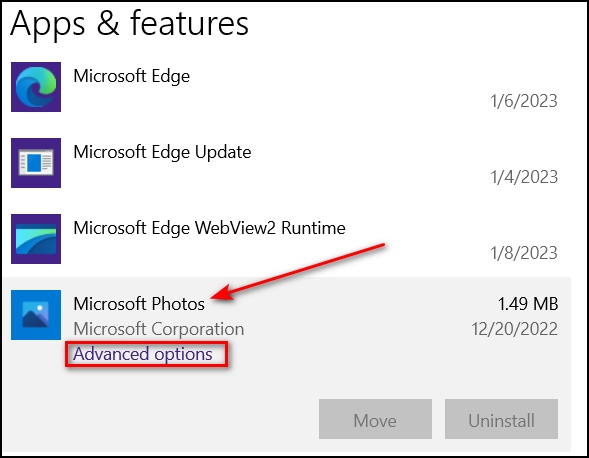
Click on Advanced options. You’ll see the option to repair or reset the app.
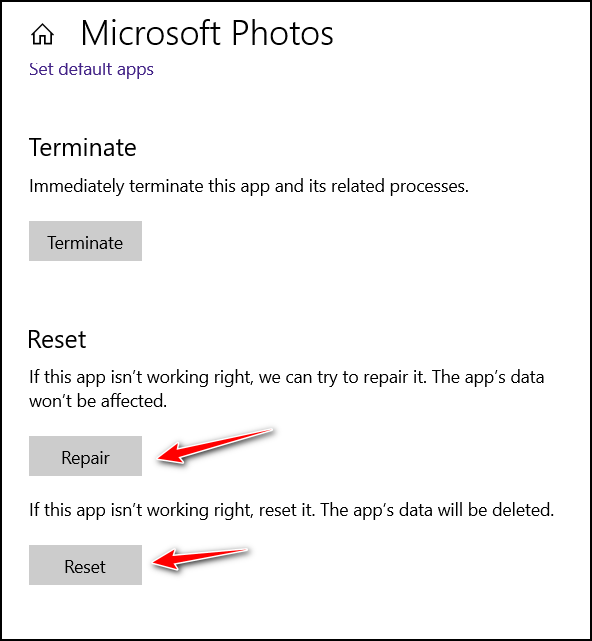
Windows 11
Open Settings (Windows key + I) and click on Apps. In “Apps” click on “Installed apps”. Then find the app you want to repair or reset and click on the three-horizontal-dots icon to its right.

When you click on the 3-dota, you’ll see “Advanced options” appear. Click on “Advanced options…

You’ll see the “Repair” and “Reset” options. Always try the “Repair” option first. If it does not fix the app, try the “Reset” option.
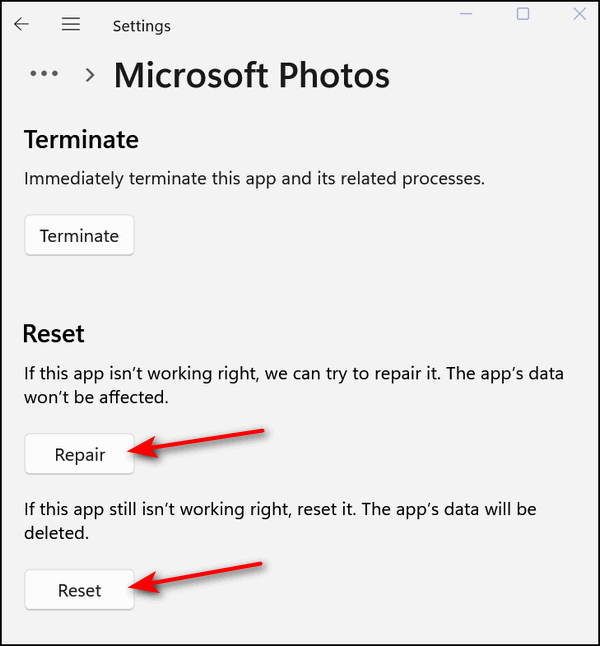
Most Windows apps allow you to repair or reset them, so if a Windows app starts misbehaving try repairing or resetting it.
Here’s Our Tutorial Showing How to Clear Your Browser’s History & Cache
Chrome / Edge /Firefox browsers
Your browser’s cache stores websites’ “static assets”, which are the parts of a website that don’t change from one visit to the next. It also contains cookies and a complete record of your browsing history.
While caching can help speed up web browsing and make pages load faster, too much of a good thing is not always a good thing.
Your browser’s cache also stores your browsing history. That’s right. Your browser’s cache contains not only website assets, cookies, and other data, but also contains your complete browsing history.
It keeps a record of all the web pages you’ve visited since the last time you cleared your browser’s cache. Think of your browser’s cache as its stash – where it stashes away just about everything you see or do while you’re using it.
Even if you don’t care that someone can look at your browser’s cache and see every page you’ve ever visited, since the last time you cleared your cache, it’s a matter of good housekeeping to clean up the cache at least once a month.
Here’s our guide to clearing the cache for the three most popular web browsers. We will do this in the order of the browser’s popularity.
#1. Google Chrome
Click on the 3-vertical-dots icon in the top-right corner of Chrome. Then click “More tools” > “Clear browsing data”. Or if you’re a keyboard shortcut enthusiast, open Chrome, and press CTRL+SHIFT+DELETE to open the “Clear browsing data” dialog.
When the Clear browsing data dialog opens, select a time range. We suggest you choose “All time” as this will clear all Chrome history/cache.
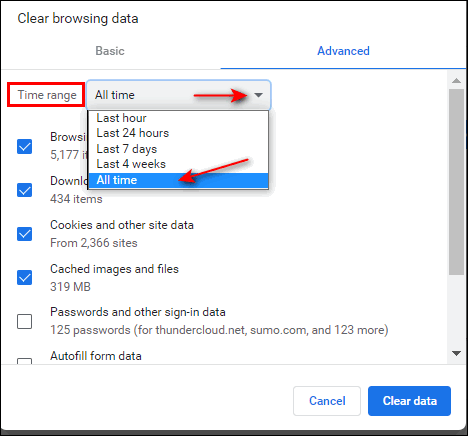
Next, select what you want to clear. Be careful here. If you use Chrome to store your passwords and sign-in data, you’ll want to make sure you don’t select “Passwords and other sign-in data”. We suggest you use the screenshot below as a guide.
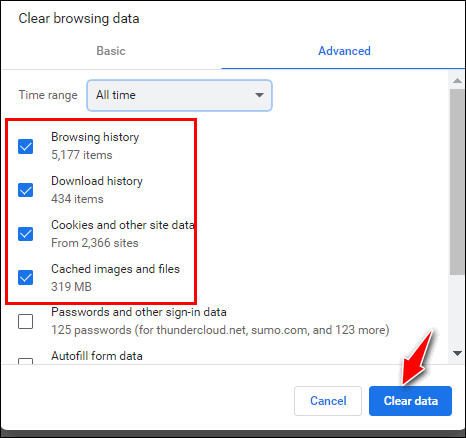
When you’ve made your selections, just click the “Clear data” button. Keep in mind if you have never cleared Chrome’s cache/history, it may take a while to complete this task.
#2. Microsoft Edge
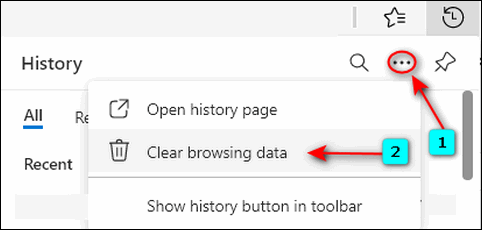
When Edge History opens, click on the 3 horizontal dots icon (see above). Then click “Clear browsing data” (see above).
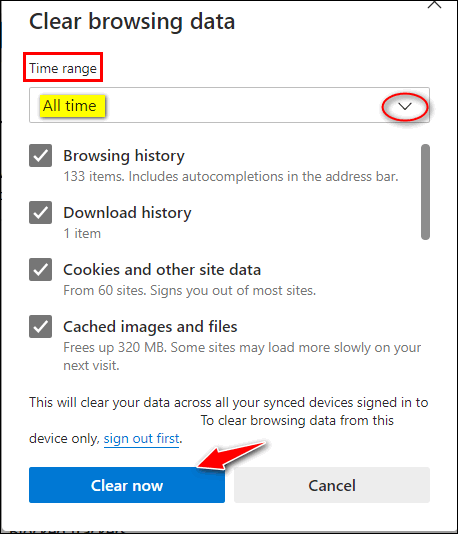
That’s it. That’s how to clear your history/cache in Edge.
To clear Firefox history/cache, open Firefox and click on the hamburger (3-horizontal lines) icon in the top-right corner and select “History > Clear recent history” or, with Firefox open, use the CTRL+SHIFT+DELETE shortcut to go directly to the “Clear recent history” dialog.
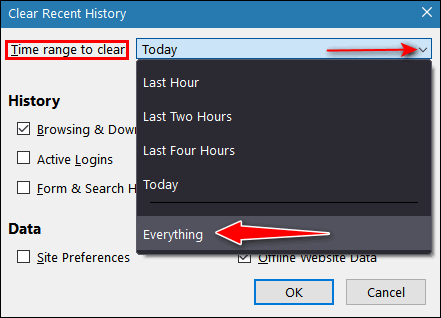
With “Everything” selected, you can choose what items you want to delete. You can use the screenshot below as a guide. The items we have selected in the screenshot below should be fine for most of you.
When you’ve made your selections, click “OK” to clear your Firefox history and cache.
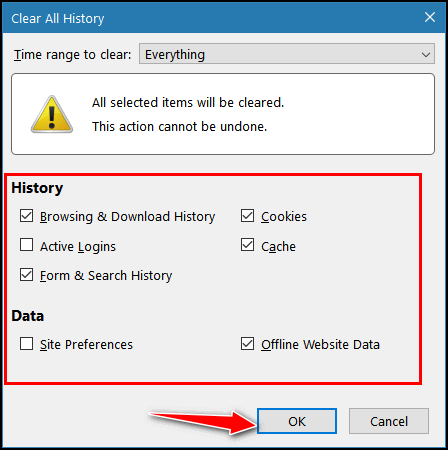
Your browser’s cache is its stash
Your browser’s cache stores the static assets of all the websites you’ve visited. Static assets are the parts of the websites you visit that don’t change from one visit to the next. It also contains all the cookies dropped by the sites you’ve visited. It also contains a complete record of your browsing history. All of these are stored until you flush them away by clearing your browsing history and cache.
![]()
How to Change Your Mouse Pointer Size and Color
Windows 10 & Windows 11
A not-so-well-known feature of Windows allows you to customize your mouse pointer size and color. You can make the mouse pointer very small or very large – or any size in between by using a size slider. And you can make your mouse pointer any color you want.
Windows 10
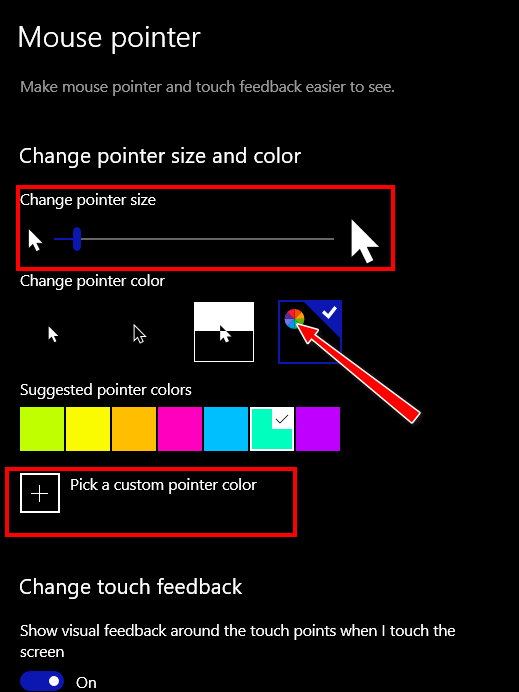
In the Ease of Access > Mouse pointer settings page, you’ll find a slider that lets you make your mouse pointer as big or as small as you like. And you’ll find an option that allows you to change your mouse pointer color.
Once you click on the “color wheel” option (see above) Windows will display seven color boxes showing you pointer colors you can choose. But if you don’t like any of those colors, just click the plus sign + next to “Pick a custom pointer color” and choose any color you like.
All you need to do to get the “Mouse pointer” settings page is: Press the Windows Key + U to open the Ease of Access Center. In Ease of Access click on “Mouse pointer” in the menu on the left.
Windows 11

Once you choose a mouse pointer style, you can choose a color by clicking on any of the colored squares. If you don’t like any of the available colors, click on “+ Choose another color” and choose any color you want. And just as in Windows 10, you’ll find a slider that lets you make your mouse pointer as big or as small as you like.
The fastest way to get to the mouse pointer settings in Windows 11 is by typing “MOUSE POINTER AND TOUCH”(without quotes) in the taskbar search and pressing enter when you see “Mouse pointer and touch” appear in the search results.
Want more tips, tricks, and information?
We have thousands of Windows tips, tricks, and more on our InfoAve website.
Subscribe to our free InfoAve Daily newsletter.
![]()

THANK YOU FOR HELPING US!
When you support us with a small gift, you help us continue our mission
to keep you informed, separate the truth from the hyperbole, and help
you stay safer online. Plus, our computer tips make your computer easier
to use.
Did you know that we provide support to thousands of people? Every week,
we help dozens of people via email at no charge. The questions and
answers you see in our newsletters are from the email answers and help
we provide to everyone free of charge.
Thanks to your gifts, we do a lot more than provide this free newsletter. We help you recognize online threats, fight for your online privacy, provide you with the knowledge you need to navigate the Web safely, provide you with suggestions for safe, free software and websites, and help you get more out of your PC.
Please help us keep up the good fight with a small gift.
Interested in making an automatic monthly gift? Visit this page. Help us keep helping you... and help us keep you safe on the Web
![]()

Animated GIFs Made Easy with Sceen2Gif
Screen2Gif is a free program for Windows 10 and Windows 11 that can record your screen and webcam and save whatever you record as an animated GIF. It also comes with a sketch board that you can use to create animated drawings and more.
You can record whatever is on your screen, edit your creations, and then export them as animated GIFs. You can also create your own original animated GIFs using the sketch board.
Screen2Gif is 100% free. It’s 100% free from malware and tricks, too. It is very easy to use and has many advanced features that experienced users will love. Yet Screen2Gif is so easy to use that beginners will be able to start using it right away.
Here are just a few of the many features of Screen2Gif:
Add captions, text, drawings, or shapes
Add keystrokes and mouse clicks
Add borders, and shadows, and obfuscate (pixelate)
Add watermarks using your own images
Undo, redo, or reset your edits
Copy, cut, and paste frames
Select multiple frames or browse to a specific frame
Preview the playback of the animation
Capture the mouse cursor and mouse clicks
Remove duplicates
Reduce framerate
Delete all previous or all next frames
Import frames
Resize, crop, or flip/rotate
… and many, many more
The Screen2Gif website has an excellent help section showing how to use all the features of the program. You’ll find guides and screenshots to help you get the most out of the program.
The ways you can use Screen2Gif are limited only by your imagination. You can use it for presentations, show people how to do computer-related tasks, use it to make interesting content for your social media posts, and more.
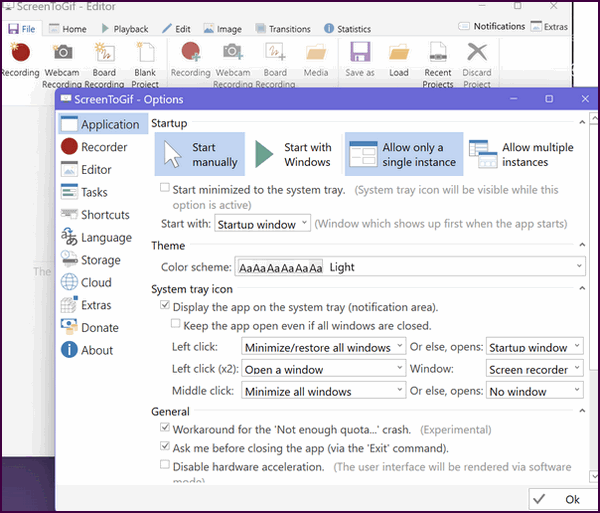
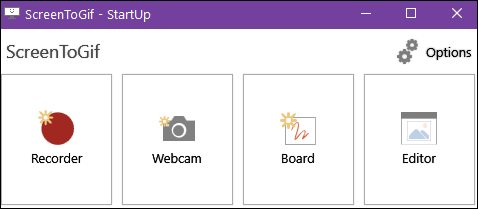
Screen2Gif is completely free and works on Windows 10 and Windows 11. Yes, we tested it on both Windows 10 and Windows 11. You can download it with an installer or as a portable version. Both the installer and the portable version are clean and free from tricks, PUPs, and malware.
Read more about and/or download Screen2Gif here.
Look Out Below!
I had some fun trying out Screen2Gif.
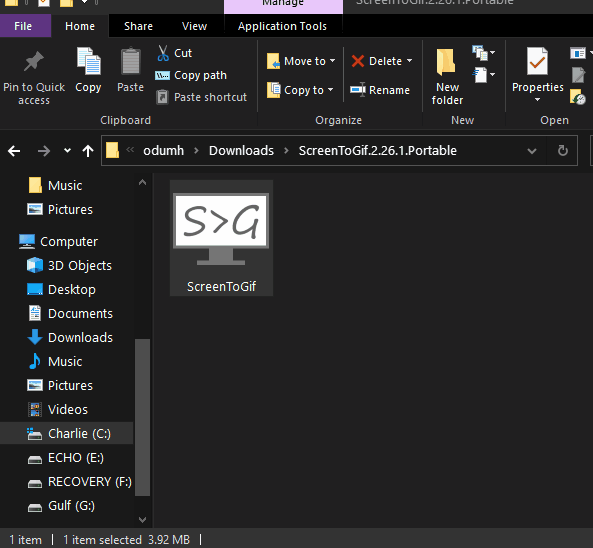
Above: After downloading the portable version and extracting the zip file, I created shortcuts on my Start menu and the taskbar.
Below: I use my artistic ability to show you my portrait of EB. While I’m not an artist, I did get the eyes and hair right!
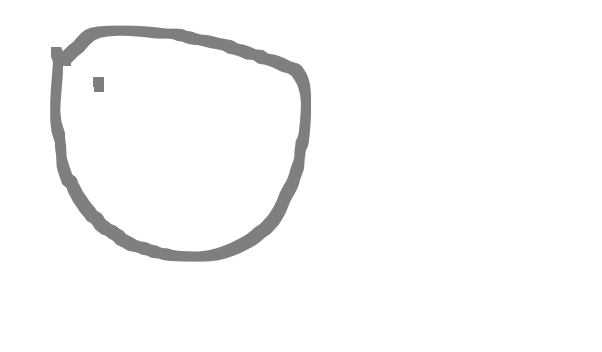
![]()

Father Andrew
It doesn’t seem that long ago since I last passed Andrew on the hiking path. But it’s been years since we met and years since I last saw him. And I am not sure, exactly, why I’m thinking about him today. Well, I guess I do. Today would have been his 85th birthday. It still may be, I don’t know, I haven’t seen him in months.
Since it was first built, I’ve been walking the wooden boardwalk that winds through a beautiful forest. While it seems to be fairly new, it was built over 10 years ago. Before its construction, I used to walk on the dirt path that wound its way through the dense woods. Many times I tripped over a vine or a branch, but being a younger version of myself, no bones were broken and no damage was done.
And before I get back to Andrew, I want to tell those of you who don’t know about my dedication to walking, I think walking has saved my life. I’ve been walking daily for almost 15 years. Ever since I realized that my 18-year-old mind resides in a 70+-year-old body – replete with 70+ year-old ailments, aches, and other foibles.
I walk when it’s 95 degrees...
Read the rest of this essay here.

What does "tweak" mean?
Tweak is a new word that means when young girls dance obscenely while scantily clad. Oh, that's right, I was thinking of twerking...thanks EB, I'm not up on all those dances you and your friends do.
Moving right along...Seriously folks... Tweak means to change something slightly so that is more optimized, more user-friendly, or more effective. For example, you can change the default download location when you download a file. That's called a browser tweak. Some tweaks are simple to do, while others require registry changes and must be done with care and used with caution. And sometimes a tweak can be nothing more than settings changes. A tweak can be a settings change to make your computer easier for you to use, a registry edit that adds or removes a feature, or any small change you make that enhances your Windows experience. So, any time you change something on your PC to make it easier for you to use or easier to accomplish a task - you're tweaking.
![]()

Sales of the following products and services help support our newsletters, websites, and free computer help services we provide.
Cloudeight Direct Computer Care:
Single Keys, SeniorPass, or Season Tickets - always a great deal. Cloudeight Direct Computer Care is like having PC insurance.
Get more information here.
Emsisoft Anti-Malware: Emsisoft is the only Cloudeight-endorsed and recommended Windows security program. It provides users with a complete antivirus, antimalware, anti-ransomware,
and anti-PUPs solution. We offer single Emsisoft licenses and multi-computer licenses at discount prices. Also, we offer our exclusive Emsisoft with Cloudeight installation & setup.
Get more information here.
Reg Organizer: Reg Organizer is the Swiss Army Knife of Windows tools. It's far more than just a registry optimizer and cleaner... it's a Windows all-in-one toolkit. Reg Organizer helps you keep your computer in tip-top shape and helps you solve annoying Windows problems. Reg Organizer works great with Windows 10
and Windows 11! Get more information about Reg Organizer (and get our special discount prices) here.
MORE IMPORTANT STUFF!
Your InfoAve Weekly Members' Home Page is located here.
Help us grow! Forward this email newsletter to a friend or family member - and have them sign up for InfoAve Weekly here!
Get our free daily newsletter! Each evening, we send a short newsletter with a tip or trick or a computer-related article - it's short and sweet - and free. Sign up right now.
We have thousands of Windows tips and tricks and computer articles posted on our Cloudeight InfoAve website. Our site has a great search engine to help you find what you're looking for, too! Please visit us today!
Help us by using our Start Page. It costs nothing, and it helps us a lot.
Print our Cloudeight Direct Flyer and spread the word about our computer repair service! If you want to help us by telling your friends about our Cloudeight Direct Computer Care service, you can download a printable flyer you can hand out or post on bulletin boards, etc. Get the printable PDF Cloudeight Direct Computer Care flyer here.

We'd love to hear from you!
If you have comments, questions, a tip, a trick, a freeware pick, or just want to tell us off for something, let us know.
If you need to change your newsletter subscription address, please see "Manage your subscription" at the very bottom of your newsletter.
We received hundreds of questions for possible use in IA news. Please keep in mind that we cannot publish all questions and answers in our newsletters, but we try to answer every single question. We can only use a few in each week's newsletter. If you have a support question about a service or product we sell, please contact us here.
Subscribe to our Daily Newsletter! Get computer tips & tricks every night. Our daily newsletter features a computer tip/trick or two every day. We send it out every night around 9 PM Eastern Time (USA). It's short and sweet, easy to read, and FREE. Subscribe to our Cloudeight InfoAve Daily Newsletter!

We hope you have enjoyed this issue of Cloudeight InfoAve Weekly. Thanks so much for your support and for being an InfoAve Weekly subscriber.
Have a great weekend. Be safe!
Darcy & TC
Cloudeight InfoAve Weekly - Issue #1137
Volume 22, Number 40
July 25, 2025
Not a subscriber? Subscribe to our FREE Cloudeight InfoAve Weekly Newsletter here.

"Cloudeight InfoAve Weekly" newsletter is published by:
Cloudeight Internet LLC
PO Box 73
Middleville, Michigan, USA 49333-0073
Read our disclaimer about the tips, tricks, answers, site picks, and freeware picks featured in this newsletter.
Copyright ©2025 by Cloudeight Internet

